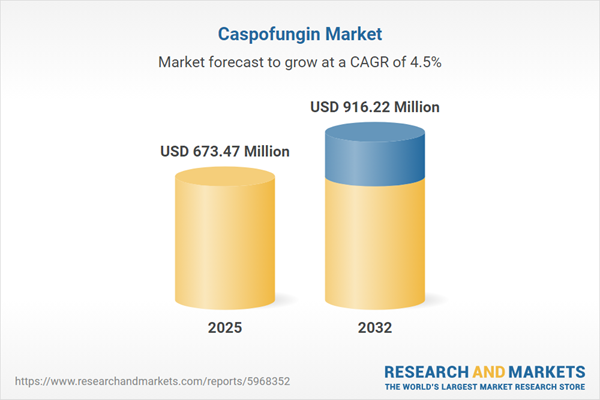Speak directly to the analyst to clarify any post sales queries you may have.
The Caspofungin Market is undergoing significant transformation as global healthcare systems prioritize advanced solutions to combat complex fungal infections. Senior executives face a shifting ecosystem that requires adaptive strategies, informed investment decisions, and clear visibility into regulatory and competitive trends.
Market Snapshot: Caspofungin Market Size and Growth Outlook
The Caspofungin Market is projected to expand from USD 643.80 million in 2024 to USD 673.47 million in 2025, reaching an estimated USD 916.22 million by 2032, at a CAGR of 4.50%. This growth is attributed to the wider adoption of targeted antifungal therapies, integration of innovative technologies, improvements in infection management protocols, and the urgent need for more reliable clinical outcomes. Collaborative efforts among pharmaceutical companies and healthcare organizations are influencing the evolving competitive landscape and supporting alignment with emerging industry standards.
Caspofungin Market Scope & Segmentation
- Therapeutic Indications: Caspofungin is instrumental in managing esophageal candidiasis, invasive aspergillosis, and invasive candidiasis. Customizable treatment protocols remain essential for tailoring care to varied patient needs and optimizing therapeutic outcomes.
- Formulation Types: Caspofungin is available as lyophilized powder and pre-mixed solutions, enabling flexible administration in diverse clinical environments. These formulations streamline integration into workflows and reinforce safety practices.
- Product Types: The market includes branded, generic, and biosimilar offerings, supporting procurement strategies based on cost efficiency, access objectives, and diverse patient needs.
- End User Environments: Hospitals, specialty clinics, and primary care providers utilize caspofungin across a spectrum of infection management scenarios, making operational flexibility and adaptability to different care models increasingly relevant.
- Distribution Channels: Delivery to end users is facilitated through hospital pharmacies, retail outlets, and large supply chains, supporting ongoing access and operational continuity across multiple care settings.
- Regional Markets: The Caspofungin Market covers the Americas, Europe, Middle East & Africa, and Asia-Pacific, each influenced by unique healthcare regulations, infrastructure capabilities, and local initiatives. Understanding these regional distinctions is vital to ensure effective market entry and consistent product availability.
- Key Companies: Leading players such as Merck & Co., Sandoz International, Teva Pharmaceutical Industries, Viatris, Natco Pharma, Biocon, Cipla, Dr. Reddy’s Laboratories, Apotex, and Fresenius Kabi are central to driving innovation and expanding accessibility.
Key Takeaways for Senior Decision-Makers
- Caspofungin supports diverse infection management protocols, allowing organizations to respond effectively to critical care and evolving patient needs.
- Advances in drug formulation and delivery methods promote compatibility with a broad range of healthcare environments, enhancing both routine and urgent care practices.
- Optimized use of technology in supply chains increases procurement efficiency, sharpens resource planning, and improves risk management throughout the distribution process.
- Robust sourcing and diversified supplier networks are necessary to ensure steady access, especially during market disruptions and global operational shifts.
- Integration of biosimilars and strategic collaborations contribute to market resilience, offering flexibility to adapt to changing regulatory requirements and supply chain challenges across key regions.
- Localized strategies in regulatory compliance and operations help minimize market entry barriers and align service delivery with regional policy and infrastructure standards.
Tariff Impact: Navigating Regulatory and Economic Shifts
Recent evolutions in global pharmaceutical tariffs have prompted organizations to enhance supplier diversity and extend logistics capabilities. Strategic planning and robust procurement approaches help sustain regulatory compliance and uninterrupted caspofungin supply as frameworks adjust. These measures strengthen adaptability to both immediate and future economic and regulatory shifts.
Methodology & Data Sources
The insights presented in this Caspofungin Market report derive from in-depth qualitative and quantitative methods, encompassing clinical trial analysis, expert interviews, and comprehensive literature review. This rigorous process ensures relevance for healthcare leaders needing actionable, market-aligned intelligence.
Why This Report Matters
- Empowers healthcare executives to anticipate industry shifts and adjust antifungal strategies based on comprehensive, data-driven insights.
- Enables organizations to refine procurement and supply chain protocols, thus improving resilience against operational and market fluctuations while supporting efficient resource allocation.
- Guides the development of regionally responsive operational plans, ensuring tailored approaches that sustain competitiveness and meet evolving standards in multiple healthcare markets.
Conclusion
This report equips senior decision-makers with clear, timely analysis to guide strategic planning, enhance operations, and identify new growth opportunities in the Caspofungin Market.
Additional Product Information:
- Purchase of this report includes 1 year online access with quarterly updates.
- This report can be updated on request. Please contact our Customer Experience team using the Ask a Question widget on our website.
Table of Contents
3. Executive Summary
4. Market Overview
7. Cumulative Impact of Artificial Intelligence 2025
Companies Mentioned
The companies profiled in this Caspofungin market report include:- Merck & Co., Inc.
- Sandoz International GmbH
- Teva Pharmaceutical Industries Ltd.
- Viatris Inc.
- Natco Pharma Limited
- Biocon Limited
- Cipla Limited
- Dr. Reddy's Laboratories Limited
- Apotex Inc.
- Fresenius Kabi AG
Table Information
| Report Attribute | Details |
|---|---|
| No. of Pages | 192 |
| Published | October 2025 |
| Forecast Period | 2025 - 2032 |
| Estimated Market Value ( USD | $ 673.47 Million |
| Forecasted Market Value ( USD | $ 916.22 Million |
| Compound Annual Growth Rate | 4.5% |
| Regions Covered | Global |
| No. of Companies Mentioned | 11 |









